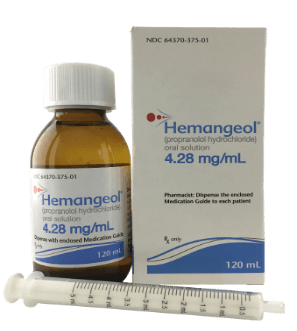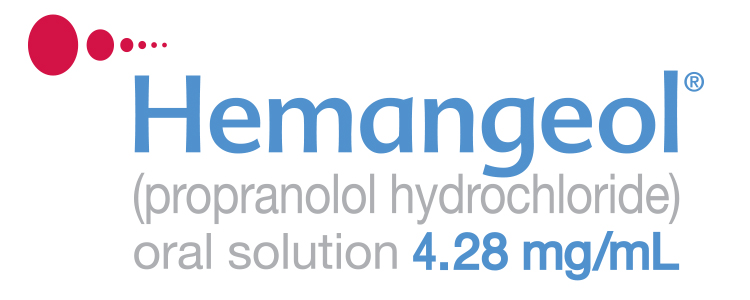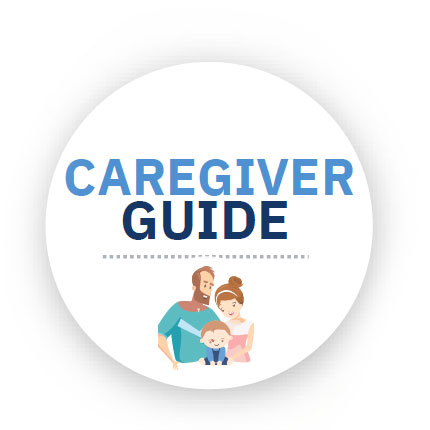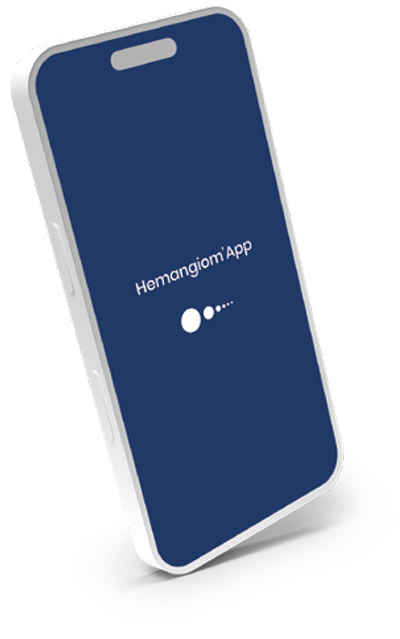A Safe and Effective Treatment for Infantile Hemangioma Is Here
The First and Only FDA-Approved Treatment for Proliferating Infantile Hemangioma Requiring Systemic Therapy
Pay no more than $47
*Coupon offer may not be used with Medicare Part D, Medicaid, Va/DoD, Tricare or other federal or state health care programs. Please see program conditions and eligibility criteria to apply.
What is Infantile Hemangioma?
Infantile hemangiomas, sometimes called “strawberry marks,” are benign tumors formed from the overgrowth of blood vessels on or under the skin.
You often can’t see infantile hemangiomas when your baby is born. It may appear after a few weeks.
All infantile hemangiomas go through phases of early rapid growth (proliferation) then slowly start to improve over a span of up to 9 years.

Understanding Infantile Hemangioma

Learn About Hemangioma
Infantile hemangiomas, also known as IHs, are benign, blood-filled tumors that form due to the overgrowth of blood vessels.

Why and When to Consult?
In the vast majority of cases, the infantile hemangioma do not present any complication and disappear on their own. However, as soon as a lesion appears, do not hesitate to consult a physician, who will keep an eye on the hemangioma.

Advice for Parents
Since your baby has developed infantile hemangioma, you may be feeling confused, anxious, guilty, or concerned how others will react. The good news is there are support and advocacy groups dedicated to getting the help you and your family deserves.

Discover HEMANGEOL
- 60% of patients reached complete or nearly complete resolution of infantile hemangioma by 6 months versus 4% of patients on placebo
- 88% of patients on HEMANGEOL showed improvement after 5 weeks of treatment*
Clinically Proven Safe and Effective
- 6 out of 10 of babies on HEMANGEOL had their infantile hemangioma lesion “completely or nearly completely resolved” by 6 months of therapy versus only 4% of babies given placebo (no treatment).
- 88% of patients on HEMANGEOL showed improvement after 5 weeks of treatment. Based on independent-investigator assessment of telangiectasis, color, textural change and distortion of anatomical landmarks or skin contours compared to baseline
- Fewer than 2 out of 100 babies who were given HEMANGEOL had to stop treatment due to adverse experiences.
- Almost 9 out 10 babies treated with HEMANGEOL showed improvement after 5 weeks.
- HEMANGEOL can cause serious side effects, including low blood sugar (hypoglycemia), especially if your child is not taking feedings, or is vomiting. The most common side effects include sleep problems, worsening respiratory tract infections, diarrhea, and vomiting.

The HEMANGEOL Caregiver Guide
The Caregiver Guide provides important information on how to recognize and to manage the following risks associated with the treatment with HEMANGEOL.
- Low Blood Sugar (Hypoglycemia)
- Breathing Problems (Bronchospasm)
As with many drugs, HEMANGEOL may cause unwanted adverse effects.
These risks should be managed for the entire duration of treatment with Hemangeol for each child, including any retreatment.
The HEMANGIOM' APP
For Education and Treatment Adherence when Caring for Hemangeol Patients
Hemangiom’App is a digitalization of the caregiver guide, designed to help you manage your infant’s treatment plan through support and guidance.
This app is intended for the exclusive use of caregivers 18 years and older. The Hemangiom’ App is not intended to provide treatment decisions or replace the care and advice of a licensed healthcare provider. If you have any questions about this information, be sure to discuss them with your healthcare provider.
HEMANGEOL Health & Safety
HEMANGEOL is a clear, colorless to slightly yellow oral-dosing solution supplied in a 120 mL amber glass bottle, with a child-resistant screw-cap. A specific oral syringe and syringe adapter are provided with each bottle. The oral dosing syringe measures HEMANGEOL according to volume in milliliters (mL).
HEMANGEOL is available in strawberry-vanilla flavor.
HEMANGEOL is:
- Alcohol-free
- Sugar-free
- Paraben-free

Patient Testimonials
Questions For Parents
Infantile hemangiomas, sometimes called “strawberry hemangioma,” are benign tumors formed from the overgrowth of blood vessels on or under the skin. Infantile hemangiomas are the most common benign tumors of infancy—affecting up to 10% of all infants and up to 30% of premature babies. An infantile hemangioma (IH), for the most part, is not present at birth, though there can be a “pre-warning” outline (light red and subtly elevated) where a deeper, raised hemangioma will soon appear. A congenital hemangioma (CH) is different and is fully present at birth, though it can grow a little after birth.
In some severe cases, infantile hemangiomas can interfere with an important function:
- On the eyes, it can affect your baby’s vision, especially because eye development is crucial at an early age
- On the nose, it can affect your baby’s breathing
- On the mouth, it can affect your baby’s food intake
Some infantile hemangiomas are at high risk of bleeding, which can lead to anemia, blood transfusion, and/or infection. Infantile hemangiomas that are bleeding can also be extremely painful for your baby.
Some hemangiomas stop growing soon after they appear, but this is rare. Most hemangiomas go through a rapid growth cycle of 1 week to 16 weeks. The Infantile Hemangioma then seems to go quiet for a few weeks. From about 6 months to a year, there can be a little more growth. However, most of the growth occurs within the first 4 months. There are reports of hemangiomas growing past one year, but this is rare.
Babies fall and get bumps, cuts, and bruises all the time. A hemangioma, if cut, can be a scary mess. They bleed a lot because they are hyper-vascular. Direct pressure applied to the hemangioma will help the bleeding to stop. A little petroleum jelly and pressure bandage can be applied as well. If it continues to bleed the baby should be taken to pediatric Urgent Care.
Yes. No matter how big or how small, any lesion on the upper or lower eyelid can result in astigmatism or other eye complications if not treated immediately. The slightest pressure against the globe (eyeball) can reshape it and cause astigmatism. If your baby has an eyelid hemangioma, insist on treatment and discuss treatment options with your doctor and get regular pediatric eye exams.
Hemangiomas grow quickly and appear shortly after your baby is born. By the time your baby is 3 months old, the hemangioma growth will be 80% complete. However, infantile hemangiomas can grow until your baby is up to 6 months of age.3 Earlier treatment prevents faster and larger growth of the infantile hemangioma and lowers the risk of permanent scarring and disfigurement.
For more information please visit our Parent Resources for Infantile Hemangioma.
Download the FAQ Guide of the Vascular Birthmarks Foundation using the button below. To learn more about the Vascular Birthmarks Foundation, visit their website.
The Vascular Birthmarks Foundation website is not owned or operated by Pierre Fabre. Links to all outside sites are provided as a resource only. Pierre Fabre accepts no responsibility or liability for the content or services of other websites.
What is HEMANGEOL
(propranolol hydrochloride oral solution)?
Download Important Safety Guide
Important Safety Information for HEMANGEOL
Do not give HEMANGEOL to your child if your child:
- was born prematurely and has not reached the corrected age of 5 weeks
- weighs less than 4 ½ pounds
- is allergic to propranolol or any of the other ingredients in HEMANGEOL
- has asthma or a history of breathing problems
- has a heart problem, slow heart rate (less than 80 heart beats per minute), very low blood pressure
- is at risk for low blood sugar, for example is vomiting or unable to take feedings
- has high blood pressure caused by a tumor on the adrenal gland, called “pheochromocytoma”
Tell your doctor about all of your child’s medical conditions, all of the medicines your child takes, and all of the medicines that you take if you are breastfeeding your child.
HEMANGEOL can cause serious side effects, including:
Low blood sugar (hypoglycemia), especially if your child is not taking feedings, or is vomiting. HEMANGEOL may make it more difficult to recognize the signs and symptoms of low blood sugar in your child. To help reduce the risk of low blood sugar with HEMANGEOL, give HEMANGEOL during or shortly after feeding your child. Feed your child regularly during treatment. Tell your doctor if your child has a poor appetite. If your child is not taking feedings, due to an illness or vomiting, do not give HEMANGEOL until your child is taking feedings normally again.
If your child has any of the signs or symptoms of low blood sugar listed below during treatment with HEMANGEOL, stop giving your child HEMANGEOL and call your doctor or go to the nearest emergency room right away.
Signs or symptoms of low blood sugar include: pale, blue or purple skin color, sweating, irritability, crying for no apparent reason, irregular or fast heartbeat, poor feeding, low body temperature, unusual sleepiness, seizures, breathing stops for short periods of time, and loss of consciousness
If your child is conscious, give him/her a drink of a liquid containing sugar.
Other serious side effects can include:
- New or worsening slow heart rate (bradycardia) or low blood pressure (hypotension).
- Breathing problems or wheezing.
- Stroke. HEMANGEOL may increase the risk of stroke in certain children who have severe problems with the blood vessels in their brain, particularly if your child has a large hemangioma that affects the face or head.
Call your doctor or go to the nearest hospital emergency room if your child has:
- pale skin color, slow or uneven heartbeats, arms or legs feel cold, blue or purple skin color, or fainting.
- breathing problems or wheezing during treatment with HEMANGEOL.
The most common side effects include: sleep problems, worsening respiratory tract infections, diarrhea, and vomiting.
These are not all the possible side effects of HEMANGEOL. Call your doctor for medical advice about side effects.
You are encouraged to report negative side effects of prescription drugs to the FDA. Visit www.fda.gov/medwatch or call 1-800-FDA-1088.
Please see Full Prescribing Information and Medication Guide.
Physician Discussion Guide
Making the Most of Your Office Visit
Talking to your baby’s doctor is very important. It can help you develop a better understanding of infantile hemangioma, the impact it may have on your baby, and the treatment options that are available.






